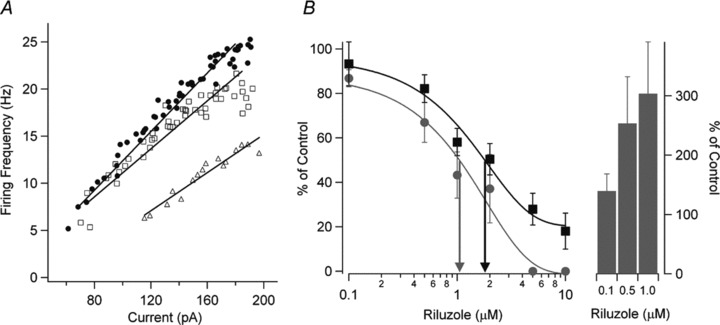Figure 1.

Riluzole inhibits neuronal excitability and the persistent Na+ current (INaP) in cultured spinal neurons in a dose‐dependent way. (A) The relationship between firing frequency and current injection (F–I) and linear regressions are shown for control (•), 0.1 μM riluzole (□), and 1.0 μM riluzole (▵). The F–I gain is reduced and the current threshold for the onset of firing is increased with increasing riluzole concentrations. (B) The dose–response curve for all cells is shown for the effect of riluzole on the F–I gain (gray circle) for 0.1 μM riluzole (n = 11), 0.5 μM riluzole (n = 10), 1 μM riluzole (n = 8), 2 μM riluzole (n = 5), 5 μM riluzole (n = 5), and 10 μM riluzole (n = 5). The effect of riluzole on INaP (▪) is also shown for 0.1 μM riluzole (n = 6), 0.5 μM riluzole (n = 5), 1 μM riluzole (n = 7), 2 μM riluzole (n = 5), 5 μM riluzole (n = 5), and 10 μM riluzole (n = 5). The EC50 for riluzole inhibition of the F–I gain (gray arrow) was 1.1 μM and the EC50 for inhibition of INaP (black arrow) was 1.8 μM. Riluzole also dose‐dependently increased the current threshold for firing (right side, bars; mean ± SEM shown for [B]). Threshold amplitudes could not be measured above 2 μM riluzole because spiking behavior became very irregular. Reprinted from [17], copyright (2006), with permission from John Wiley & Sons.
